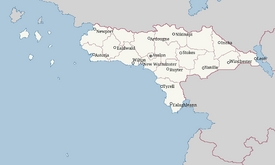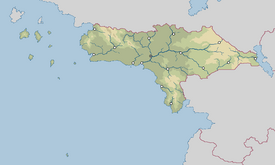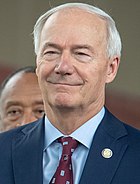Halland: Difference between revisions
m (→Government) |
|||
| Line 145: | Line 145: | ||
| style="text-align:center;"| [[File:Official_Portrait_of_Kentucky_Governor_Andy_Beshear_(cropped).jpg|140px]] | | style="text-align:center;"| [[File:Official_Portrait_of_Kentucky_Governor_Andy_Beshear_(cropped).jpg|140px]] | ||
|- | |- | ||
| style="text-align:center;"|[[Arthur Quinn]]<br /><small> President since | | style="text-align:center;"|[[Arthur Quinn]]<br /><small> President since 2016</small> | ||
| style="text-align:center;"|[[Sean Mac Dónaill]]<br /><small> Prime Minister since 2018</small> | | style="text-align:center;"|[[Sean Mac Dónaill]]<br /><small> Prime Minister since 2018</small> | ||
|} | |} | ||
Revision as of 16:20, 15 February 2020
This article is incomplete because it is pending further input from participants, or it is a work-in-progress by one author. Please comment on this article's talk page to share your input, comments and questions. Note: To contribute to this article, you may need to seek help from the author(s) of this page. |
Commonwealth of Halland Commonwealth of Halland Comhlathas na Tìr Hael | |
|---|---|
| Motto: Sic semper tyrannis Thus always to tyrants | |
| Anthem: "Ode to the fallen" | |
 Political map of Halland | |
 Physical map of Halland | |
| Capital | Avelon |
| Largest city | Astoria |
| Recognised national languages | Estmerish Ghailish |
| Recognised regional languages | Powhatan |
| Demonym(s) | Hallandic |
| Government | Unitary parliamentary republic |
• President | Arthur Quinn |
• Prime Minister | Sean Mac Dónaill |
| Senate | |
| National Assembly | |
| Establishment | |
• Colonisation by Estmere and Caldia | 1492 |
• Gilded Wars | 1721 |
• Independence from Gaullica | 1771 |
| Area | |
• | 1,831,549.44 km2 (707,165.19 sq mi) |
| Population | |
• 2015 census | |
| GDP (PPP) | 2019 estimate |
• Total | |
• Per capita | |
| GDP (nominal) | 2019 estimate |
• Total | |
• Per capita | |
| Gini (2015) | medium |
| HDI (2015) | very high |
| Currency | Pound (HLP) |
| Date format | dd.mm.yyyy |
| Driving side | right |
| ISO 3166 code | HL |
| Internet TLD | .hl |
Halland is a country in Asteria Superior, bordered by Cassier in the north, Nuxica in the south and the Vehemens Ocean to the west. It also shares a lake border with Chervolesia. The country is subdivided in 19 administrative regions, which cover an area of 1,831,549.44 square kilometers, making it the fifth largest state in Asteria. Halland is a unitary parliamentary republic with its capital in Avelon. Its largest city and main commercial center is Astoria, located on the northern coast of the nation. Other major cities include Ealaghleann, Stokes and Leon. Estmerish is the official language, although in the Fáel region, ghailish enjoys co-official status.
Indigenous Powhatan people inhabited the country for thousands of years prior to colonization. Assim Asteris and his expedition sponsored by Caldia discovered the continent in 1488, marking the beginning of colonization of the region by Euclean nations. Caldia soon after created its colony, Fáel, in the south of Halland. Soon after, Estmere established the colony of New Estmere to the north. Both colonies would grow prosperous, with the city of Astoria becoming a major port in the continent in the 17th century. Both colonies would be conquered by Gaullicia during the Gilded Wars of 1721. The new administration sponsored many policies which sparkled significant unrest, leading to various failed independence attempts and culminating in the 1764 War of Independence. Since then, Halland grew economically and became an important power in Asteria Superior, industrializing rapidly in the early 19th century and receiving many migrants. Halland was an important player in the Great War, achieving significant naval victories against Gaullica and aiding on the liberation of Nuxica.
In modern times Halland is a cosmopolitan nation with populations of a very diverse background. It is the fourth largest economy in the world by nominal GDP and the largest economy in Asteria. The nation has a significant international presence, being host of the Organization of Asterian Nations, one of the founding members of the CN, an observer member in COMSED and one of the founders of the ICD. Halland is considered a developed nation, with high standards of living and an advanced economy.
History
Pre-colonial era
Estmerish and Caldish colonization
Gaullican Administration
Independence and expansion
Industrialization and the Great War
Contemporary Era
Geography
Climate
Biodiversity
Urbanisation
Politics
Government

|
File:Official Portrait of Kentucky Governor Andy Beshear (cropped).jpg |
| Arthur Quinn President since 2016 |
Sean Mac Dónaill Prime Minister since 2018 |
Halland is a unitary parliamentary republic with a very strong democratic tradition since its foundation. Despite being a unitary state, Halland features significant levels of devolution, with regions enjoying varying levels of autonomy. The most notable of which is the Fáel region, which has a parliament of its own and devolution of significant powers under said parliament.
The nation's legislative power is a bicameral legislature, composed of the Senate and the National Assembly is responsible for approving national law, ratifying treaties, approving the yearly national expenditure and declaring war. The legislature also has power of Impeachment, as well as appointing a Prime Minister, who is the country's Head of Government.
Executive power is divided between the President, who is Head of State. and Prime Minister. While most executive power is exercised by the Prime Minister through appointed Ministers, the President is Commander-in-chief of the Armed Forces, can veto legislative proposals before they become law, and represents the country diplomatically in international summits and events.
The Judiciary is represented in its highest level by the Supreme Court and its lower instances. Ministers of the Supreme Court are appointed by the President, and are responsible for interpreting laws and their rulings are binding upon all lower courts. They also hold the power of retrial and can also reject laws considered unconstitutional. It is composed of 9 Ministers. Other than the Supreme Court, the Fáel Region also has the Superior Court of Fáel, which acts an intermediate court instance between conventional judicial instances and the Supreme Court. Regarding laws approved by the Parliament of Fáel, it also is not subject to further review by the Supreme Court.
Halland's Lower House, the National Assembly, is composed of 639 seats, which are elected to serve for 4 years. Elections for the National Assembly are done through Proportional Representation, where each of the 19 administrative regions are granted a seat per 100,000 inhabitants. The Senate has 76 voting members, with four senator seats given to each administrative region. Senators are elected through Single Transferable Vote, where each voter may list four candidates in order of preference. Election terms for the Senate last 8 years, with half the Senate elected every four years. Presidential elections happen every four years, and an elected president may be reelected no more than once. The Prime Minister is not elected, instead being chosen from the coalition most likely to form majority.
Each of the 19 Administrative Regions feature varying levels of autonomy and different systems of organization based on the 1988 Statute of Devolution. The Fáel Region has a Parliament of its own, organized in an unicameral legislature. Since the statute of Devolution, all Administrative Regions have elections in place for Governors, which have varying degrees of autonomy. Halland's current constitution was approved in 1974, extending local autonomy and increasing the powers of the legislative over the executive. It has since then received several ammendments such as the aforementioned Statute of Devolution. Ammendments must be approved with a qualified majority by both National Assembly and Senate.
Halland's modern political environment is protagonized by four major political parties: The Union Party (UP), the Liberal Republicans (LR), the Social Democratic Party (SDP) and the Fáelian Conservative Union (FCU). The first three parties represent nation-wide movements and traditions of Conservatism, Liberalism and Social Democracy respectively. The FCU is predominant in the Fáel region, being largely assotiated with the Union Party at a national level. Recently, the Green Party has gained relevance, rising in representatives both in Halland's National Assembly and Senate. The Green Party has achieved its first prefecture in 2016, in Tyrell.
Devolved Administrations
Law
Foreign Relations
Military
Economy
Companies
Energy and Infrastructure
Tourism
Science and Technology
Demographics
| Largest urban centers by population | |||||||
|---|---|---|---|---|---|---|---|
| # | Settlement | Population | # | Settlement | Population |
| |
| 1 | Astoria | TBD | 11 | Ealdwald | TBD | ||
| 2 | Ealaghleann | TBD | 12 | Ruyter | TBD | ||
| 3 | Avelon | TBD | 13 | Winchester | TBD | ||
| 4 | Stokes | TBD | 14 | Wilton | TBD | ||
| 5 | Leon | TBD | 15 | Inoka | TBD | ||
| 6 | Tyrell | TBD | 16 | Nikinapi | TBD | ||
| 7 | Ardougne | TBD | 17 | Port Ailynn | TBD | ||
| 8 | New Warminster | TBD | 18 | Beaver | TBD | ||
| 9 | Yanille | TBD | 19 | Fort Kellsen | TBD | ||
| 10 | Newport | TBD | 20 | Kitigan | TBD | ||






